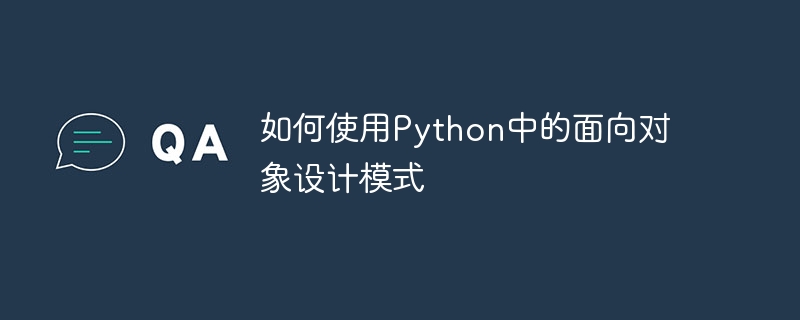

How to use the object-oriented design pattern in Python requires specific code examples
Overview:
In Python programming, the object-oriented design pattern is very important a concept. It provides a structured approach to problem solving and makes code easier to understand, maintain, and extend. This article will introduce several common object-oriented design patterns and provide specific code examples to help readers better understand and apply these patterns.
1. Singleton Pattern:
The singleton pattern is a design pattern that can only create one instance. It is suitable for situations where global uniqueness needs to be guaranteed and is frequently accessed by multiple modules or objects. The following is a simple example of the singleton pattern:
class Singleton:
__instance = None
def __new__(cls, *args, **kwargs):
if not cls.__instance:
cls.__instance = super().__new__(cls, *args, **kwargs)
return cls.__instanceIn the above code, the singleton pattern is implemented by overriding the __new__ method. __new__The method is called before the instance is created and can control the instance creation process. By determining whether the __instance attribute exists, you can ensure that only one instance is created.
Sample code using singleton mode:
a = Singleton() b = Singleton() print(a is b) # True
In the above example, a and b are both instances created through the Singleton class. Because the Singleton class is a singleton mode, a and b are same instance.
2. Factory Pattern:
Factory Pattern is a design pattern that creates different types of objects based on different inputs. It is suitable for situations where different objects need to be created based on different parameters. The following is a simple factory pattern example:
class Shape:
def draw(self):
pass
class Circle(Shape):
def draw(self):
print("Draw a circle")
class Square(Shape):
def draw(self):
print("Draw a square")
class ShapeFactory:
def create_shape(self, shape_type):
if shape_type == "circle":
return Circle()
elif shape_type == "square":
return Square()
else:
raise ValueError("Invalid shape type")In the above code, the Shape class is an abstract class and defines an abstract method draw. The Circle and Square classes inherit from the Shape class respectively and implement the draw method. The ShapeFactory class is a factory class responsible for creating corresponding objects based on input parameters.
Sample code using factory mode:
factory = ShapeFactory()
circle = factory.create_shape("circle")
circle.draw() # Draw a circle
square = factory.create_shape("square")
square.draw() # Draw a squareIn the above example, different objects are created according to different parameters through the ShapeFactory class. According to different shape_type parameters, the create_shape method returns the corresponding object, and then calls the draw method.
3. Observer Pattern:
The Observer Pattern is a one-to-many dependency relationship between objects. When the state of one object changes, it will automatically notify those who depend on it. object. The following is a simple example of the observer pattern:
class Subject:
def __init__(self):
self.observers = []
def add_observer(self, observer):
self.observers.append(observer)
def remove_observer(self, observer):
self.observers.remove(observer)
def notify_observers(self):
for observer in self.observers:
observer.update()
class Observer:
def update(self):
pass
class ConcreteObserver(Observer):
def update(self):
print("Received update from subject")
subject = Subject()
observer = ConcreteObserver()
subject.add_observer(observer)
subject.notify_observers() # Received update from subject
subject.remove_observer(observer)
subject.notify_observers() # 无输出,因为观察者已被移除In the above code, the Subject class is the observer and defines methods for adding, removing and notifying observers. The Observer class is an abstract class of observers and defines an abstract method update. The ConcreteObserver class is a concrete observer, inherits from the Observer class and implements the update method.
Sample code using the observer pattern:
subject = Subject() observer1 = ConcreteObserver() observer2 = ConcreteObserver() subject.add_observer(observer1) subject.add_observer(observer2) subject.notify_observers() # 两个观察者都收到了更新通知
In the above example, the subject object adds two observers (observer1 and observer2). When the subject object calls the notify_observers method, the two observations Everyone will receive an update notification.
Summary:
This article introduces several common object-oriented design patterns and provides specific code examples. By using these design patterns, you can make your code easier to understand, maintain, and extend. I hope readers can better understand and apply object-oriented design patterns through the introduction and sample code of this article.
The above is the detailed content of How to use object-oriented design patterns in Python. For more information, please follow other related articles on the PHP Chinese website!




